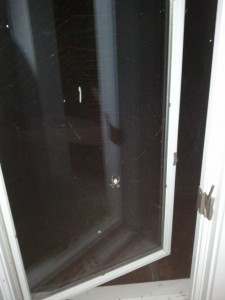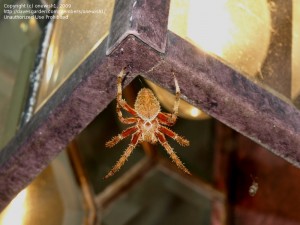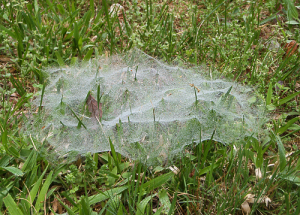A few days ago an early morning fog had thickened in the big field behind our house. The light, indirect and reflective, picked up the dew-shrouded webs, hundreds of them, every few feet. The grass spider builds these; they are both “platform and retreat,” ** her trap and her refuge. They funnel prey toward her rather than catch it through an adhesive. Grass spiders seek out our homes when winter comes.
Come closer.
In sunlight nothing remains of her except hard, keratinous shells scattered beneath the window. Her trap is all but invisible; I could walk into it, unawares. She appears only in the nighttime. Then, centered on her web, she seems regal, absolutely still in her bristly costume, every part of her attuned to vibration, waiting for the inevitable ritual.
Stretched across an open porch window, this barn spider’s web measures two feet wide by four feet long. Breezes filter through its segments, and at times it appears ragged, but those breezes also circulate prey, and she is big, an inch and a quarter across.
 I barely touched the web with a pencil point; her quickness shocks me. I recoiled. I thought she was going to leap off into my face which I held close, the better to see. What could escape her?
I barely touched the web with a pencil point; her quickness shocks me. I recoiled. I thought she was going to leap off into my face which I held close, the better to see. What could escape her?
The species is widespread in the eastern United States; look for her in “shady locations” — “barns, caves, mine openings”, doorways and  windows; sometimes she will spin “on the sides of cliffs.” I cannot find the egg casings of her young, often “attached to some shady support near the web; the young disperse soon after hatching (881).” *
windows; sometimes she will spin “on the sides of cliffs.” I cannot find the egg casings of her young, often “attached to some shady support near the web; the young disperse soon after hatching (881).” *
Closer still.
The white paint in our bedroom is one week new. To the undiscerning eye, nature has been banished. Order prevails.
Two inches from the carpet, in an obscure corner where the dresser meets the wall, a spider the size of a dust mote has constructed a web. She retreats when I breathe upon it. How did she find her way here? Maybe this explains it: “Tiny spiders have such huge brains for their body sizes that the organs can spill into the animals’ body cavities; such big brains may explain why very small spiders—some less than a millimeter across—are just as good at spinning webs as bigger arachnids.” ***
This is mid-August, and life is brimming-full and eager. It insists on unfurling itself everywhere you might look.
* The Audobon Society Field Guide to North American Insects and Spiders
